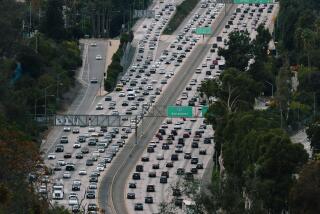Bumps in the Road : Transportation: Reopening of the quake-damaged Santa Monica Freeway has eased congestion but repairs are continuing on portions of the highway.
- Share via
Not everything was back to normal last week after the long-awaited reopening of quake-damaged portions of the Santa Monica Freeway.
*
Those who live north of the I-10 still found it hard to get onto the freeway’s eastbound lanes at La Cienega Boulevard, for example, because continuing repair work there was blocking La Cienega’s southbound traffic.
“It was an outrageous experience,” scientist Aron Wolf said of the circuitous route he had to use to reach the eastbound I-10--and his job at the Jet Propulsion Laboratory in Pasadena. “There are still pitfalls out there for the unwary motorist.”
But the southbound lanes of La Cienega under the newly rebuilt--and newly vandalized--freeway bridge will be open by early this week, transportation officials said.
And what a relief it was to have all that extra traffic off chronically congested thoroughfares, not to mention the once-quiet side streets that became popular shortcuts during rush hour.
How much traffic was there?
A lot. The Jan. 17 earthquake severed the busiest freeway in the world, an elevated roadway that carried 271,000 cars a day across the Westside.
During the time repairs were being made, traffic clogged surface streets, boosting the volume on east-west thoroughfares in some cases by more than 100%, according to city of Los Angeles traffic officials.
The highest percentage of growth--122%--was measured on Jefferson Boulevard, which runs south of the freeway before cutting down to the beach at Marina del Rey. But the biggest numbers were counted on Pico Boulevard, where traffic swelled to highs of 55,600 cars a day at the corner of Robertson Boulevard, up from an average of 32,900 before the earthquake.
Some of the pain was eased by the introduction of extra-long east-west green lights, a move that won praise from commuters.
But there were just as many complaints from north-south travelers, and the timing is now virtually back to normal, with slight changes to allow for drivers who learned to like the idea of taking surface streets.
As of Tuesday, the daily flow along Pico was measured at 35,400, up a bit from pre-quake figures, said Tom Conner, assistant general manager of the city traffic department.
The computer that helps his staff manage traffic flows is programmed to adjust itself for small-scale variations, he said, and engineers want to do what they can to encourage commuting by way of alternative routes.
“We don’t want the freeway to go back to the old congested patterns because that also has an impact on city streets,” said John E. Fisher, the city’s principal transportation engineer.
The return of the freeway was immediately noticeable to business people like Reuven Nitka, manager-owner of Nagila, a kosher pizza parlor on Pico Boulevard.
With the parking lane outside his establishment eliminated between 3 and 7 p.m., “it took people from just around the block half an hour to get here sometimes,” he said Thursday. “It’s much better now.”
While the freeway was down, federal funds helped the city of Los Angeles provide special bus service from the Westside to downtown and back. It was only faintly successful, carrying between 200 and 300 commuters a day from the Veterans Administration compound at Westwood.
But a deal has been worked out with the Metropolitan Transportation Authority to continue providing express commuter service for riders who have gotten into the bus habit, Conner said. At a cost of $1.50 each way, the service will take rush-hour riders back and forth along Olympic Boulevard or the San Diego and Santa Monica freeways. Schedules are available by calling (213) 485-7201.
More to Read
Sign up for Essential California
The most important California stories and recommendations in your inbox every morning.
You may occasionally receive promotional content from the Los Angeles Times.










